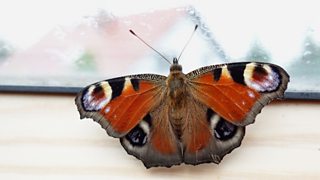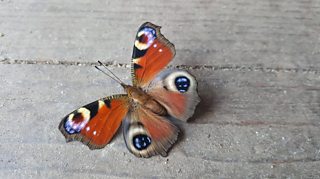Why do butterflies hibernate?
Unlike mammals and birds, butterflies and moths rely on external sources of heat to warm their bodies so that they can be active, increasing their body temperature way above ambient air temperature by basking in sunshine or ‘shivering’, which involves vibrating their flight muscles. However, when their surroundings are too cold, most butterflies and moths are forced to remain inactive.

Brimstone butterfly by Eberhard Pfeuffe
So, not surprisingly, winter poses a big problem for butterflies and (most) moths in temperate climates such as ours. It is difficult for them to get warm and, therefore, be active and so they have evolved ways of dealing with this adverse season. Most species enter a dormant phase. This can be as an egg, caterpillar, pupa or adult insect, dependent upon species. Many butterflies and moths spend winter as a caterpillar, with pupae being the next most favourable choice, followed by eggs and adults.
Those species that overwinter as dormant adults include some of the garden favourite butterflies; , , and .
Among the butterflies, it is only the small tortoiseshell and peacock that regularly overwinter inside houses. They come in during late summer/early autumn when it is still warm outside and our houses appear to provide suitably cool, sheltered dry conditions. However, come Christmas, when the central heating is often cranked up, such butterflies may be awoken prematurely by high indoor temperatures. This presents a major problem for the butterfly as the outside weather conditions may be very hostile and there is little winter nectar available in gardens.

Peacock butterfly by Jay Pegsi
What to do if you find a butterfly
It is often a problem for the concerned householder in winter, how best to help these poor confused butterflies unwittingly tricked into thinking spring has come early. Butterfly Conservation is often asked what to do with a hibernating butterfly in your home, garage or shed.
The best thing you can do is to rehouse the butterfly to a suitable location. To do this, you’ll first need to catch the butterfly carefully and place it into a cardboard box or similar and store in a cool place for half an hour or so to see if it will calm down.
Once calm, you may be able to gently encourage the sleepy butterfly out onto the wall or ceiling of an unheated room or building such as a shed, porch, garage or outhouse. It is important to remember that the butterfly will need to be able to escape when it awakens in early spring, so it’ll have to be regularly checked on or have an obvious exit to fly free.
If you have no options at all for suitable hibernation places, then Butterfly Conservation recommends keeping the butterfly cool, to minimise activity, and then to release it back outside during a spell of sunny weather.

Peacock butterfly by Kritupas Kriau膷i奴nas
As spring approaches and the UK’s butterfly population starts to become active again, remember to log your sightings using our free iRecord app which you can get from or .
